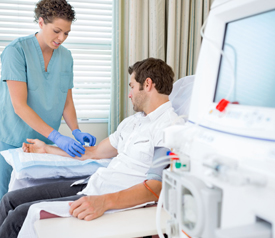
Kidney Dialysis: All About Access
If your kidneys ever fail to filter your blood, you may need kidney dialysis. Physicians use dialysis to remove wastes like urea from the blood. One of the challenges of dialysis, however, is obtaining safe and reliable access to the bloodstream. Patients generally need dialysis several times a week, so finding a durable, reusable way to filter wastes from the body is critically important.
The two types of dialysis
Dialysis can be performed in two ways: peritoneal dialysis and hemodialysis. In peritoneal dialysis, fluid is infused through a catheter into the abdomen. The dialysis fluid absorbs wastes and helps to normalize electrolyte levels. After minutes to hours, the dialysis fluid is removed through the catheter and discarded. In hemodialysis, a dialysis machine removes blood from a blood vessel, filters it, then returns it to bloodstream after it has been detoxified. Both approaches carry their own risks and benefits, but both require the same thing: access.
Types of dialysis access
Peritoneal dialysis access is rather straightforward—one catheter does it all. A flexible catheter is inserted through the skin into the abdomen. The other end of the catheter stays outside the body. The dialysis catheter is used to exchange dialysis fluids.
Hemodialysis access, on the other hand, is a bit more complex. Hemodialysis can be delivered in one of four ways:
- Non-cuffed catheter – A plastic catheter is placed through the skin into a vein. One end of the catheter opens into a large vein, while the other side of the catheter reamins outside of the body. The hemodialysis machine is connected to the exposed end of the catheter, and blood is cycled through the line. Non-cuffed catheters may be used to provide hemodialysis in emergencies or for short periods of time (< 2 weeks).
- Cuffed catheter – A cuffed catheter is similar to a non-cuffed catheter in that it is placed through the skin into a vein. However a cuffed catheter is less prone to complications and infections than a non-cuffed catheter.1 A cuffed catheter may be used for hemodialysis while the patient awaits a more permanent access (graft, fistula) to become available.
- Arteriovenous (AV) graft – An AV graft is a small plastic tube is placed completely under the skin, connecting an artery directly to a vein. Each time the patient needs hemodialysis, two needles are placed through the skin into the plastic tube. The hemodialysis machine then filters the blood it draws from the graft. Unless complications arise, an AV graft can be used for a few years before it needs to be replaced.
- Arteriovenous (AV) fistula – A surgeon connects an artery directly to a vein to form an AV fistula. An AV fistula is the person’s own blood vessels, but surgically modified. Once the fistula has healed (about six weeks after surgery), needles can be inserted into the fistula to access the patient’s bloodstream. An AV fistula can often be used for many years.
Caring for the access site: Kidney dialysis best practices
It is critical to keep any dialysis access site free from infection. An infected peritoneal catheter can spread infection to the entire abdomen. Worse still, a hemodialysis catheter infection can spread microorganisms directly to the bloodstream. Once infection sets in, the vascular access device usually must be removed and replaced. Therefore, patients, caregivers, and dialysis specialists can avoid serious complications by following some practical guidelines.
- Keep the kidney dialysis catheter or access site clean and dry. This may require frequent dressing changes. You or your provider should change the dressing after each dialysis session, or more frequently if the area becomes wet or soiled.
- Patient should know how to change their own dressings. People who perform at-home dialysis should be familiar with this, but even those who travel to a dialysis center may need to change their dressings between dialysis sessions. Patients can lower their risk for catheter infection by using proper technique and supplies.
- It is good practice to thoroughly wash your hands and use hand sanitizer before dressing changes. Try never to touch the very ends of the catheter with your bare hands, if possible.
- You may shower or bathe with your catheter, as long as the catheter is covered with waterproof dressings and tape. It is good practice never to let the catheter go completely under water, though, even if it is completely covered.
- If your catheter does get wet, make sure it dries completely before placing new dressing. You can gently dry the area with sterile gauze. Use a gentle, patting motion—never rub or put tension on the catheter.
- While a cuffed catheter should not move, it is still good practice to secure the catheter with high quality tape.
- Always follow your providers directions regarding dressings. Some providers suggest covering the catheter ports a clear, waterproof dressing. Other providers prefer covering the site with sterile gauze to help keep the area dry. In either case, these dressings should be reinforced with waterproof tape, framing the dressing on all sides.
- Check for signs of redness or warmth around the area where the catheter enters the skin. This could indicate an infection. Contact your dialysis provider if you suspect you have a catheter infection.
Choosing the right tape for dialysis access management
A big part of dialysis access management is dressing management. Having a catheter means frequent dressing changes. The tape you choose to secure those dressings should be waterproof, adhere securely, and remove cleanly without traumatizing the skin.
Hy-Tape checks all of those boxes, and even provides some additional advantages.
The Original Pink Tape® is a latex-free, zinc oxide-based tape that adheres strongly and releases cleanly. When it is time to remove Hy-Tape, it comes off without harming the skin. This feature is so important since 50 to 85% of people on maintenance dialysis suffer from severely dry skin.2 Hy-Tape is thin and flexible, so it can create a tight border around clear or gauze dressings. Since Hy-Tape is waterproof and occlusive, it repels water and contaminants, keeping the area underneath clean and dry. Hy-Tape is perhaps the ideal tape for dialysis catheter management.
References
1. Vervloet MG, Weijmer MC, ter Wee PM. Compared to Tunnelled Cuffed Haemodialysis Catheters, Temporary Untunnelled Catheters Are Associated with More Complications Already within 2 Weeks of Use. Nephrology Dialysis Transplantation. 2004;19(3):670-677. doi:10.1093/ndt/gfg581
2. Gagnon AL, Desai T. Dermatological Diseases in Patients with Chronic Kidney Disease. Journal of nephropathology. 2013;2(2):104-109. doi:10.12860/JNP.2013.17

